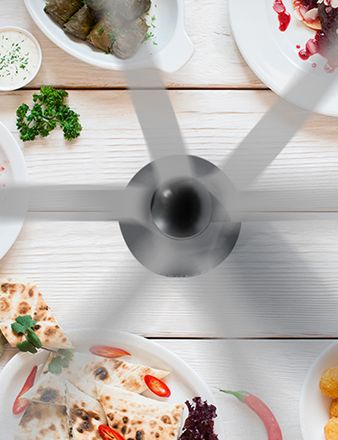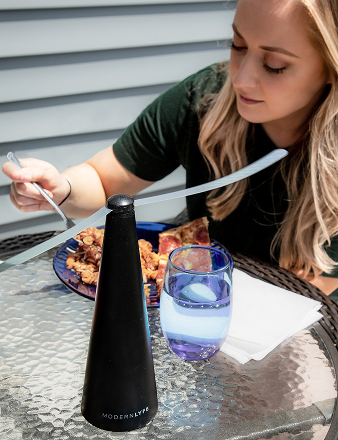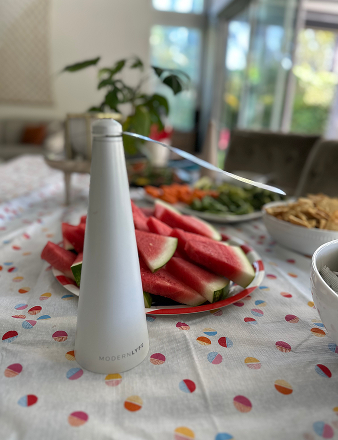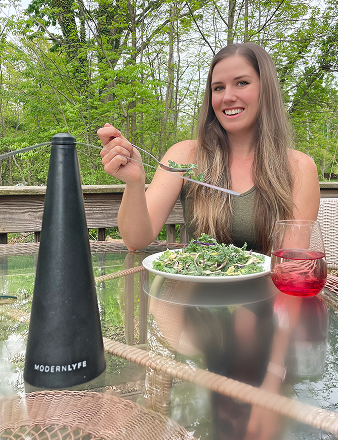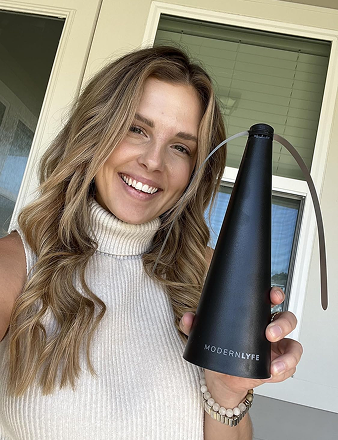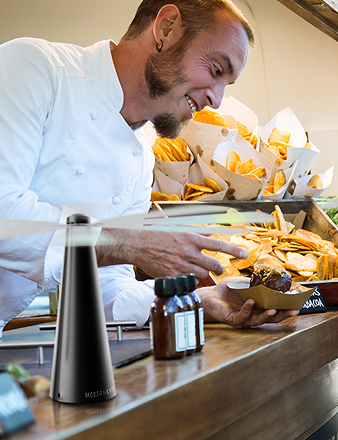Flies are annoying. Their constant buzzing can ruin a backyard barbecue or a quiet afternoon on the patio. A liquid fly trap is a simple, effective tool to get rid of them. It's a container with a special bait liquid flies can't resist, luring them in to be trapped and drowned.
It's one of the best ways to reclaim your patio, deck, or garden from these persistent and unsanitary pests.
Your Simple Solution for a Fly-Free Home
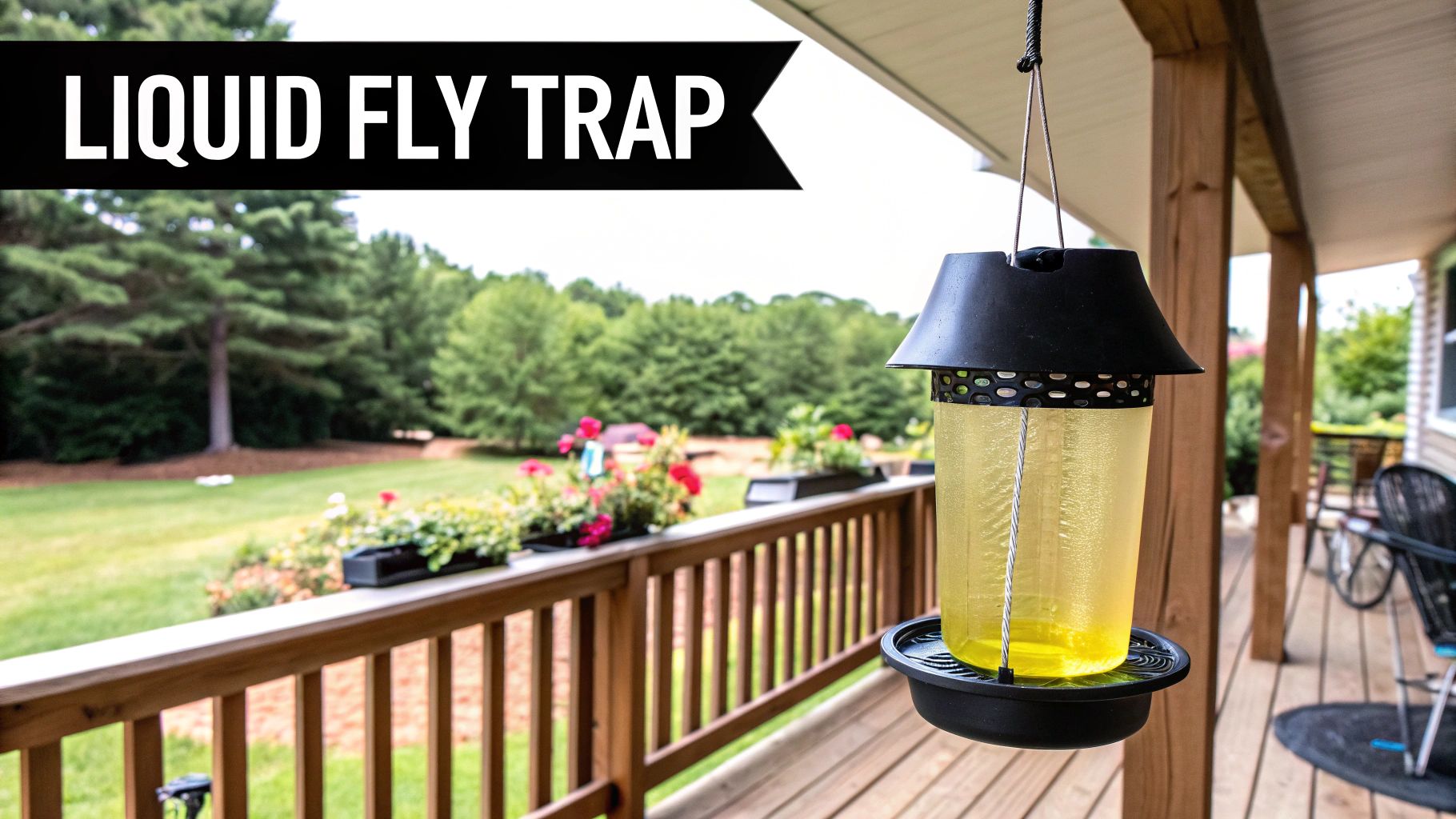
We've all been there. Flies buzzing around your food, ruining conversations, and just being a nuisance. Beyond the annoyance, they're a health risk, notorious for spreading bacteria. This guide shows you how a liquid fly trap can be your best defense.
Think of it as a clever lure, not a complex device. It works like a Venus flytrap, which uses sweet nectar to draw insects to their doom. These traps use a scent that’s irresistible to flies, pulling them away from you, your family, and your guests.
A single housefly can carry over 100 different pathogens, including germs that cause food poisoning. Reducing the fly population isn't just about comfort—it's key to maintaining a healthy space, especially where you eat.
This guide will walk you through everything you need to know. We’ll cover:
- The science behind why these traps work so well.
- Smart placement and upkeep tips for the best results.
- How to choose the right trap for your needs.
Once you know how they work and how to use them, you can turn a nagging pest problem into a non-issue. Let's make your home and yard a more comfortable, hygienic place.
How Liquid Fly Traps Work
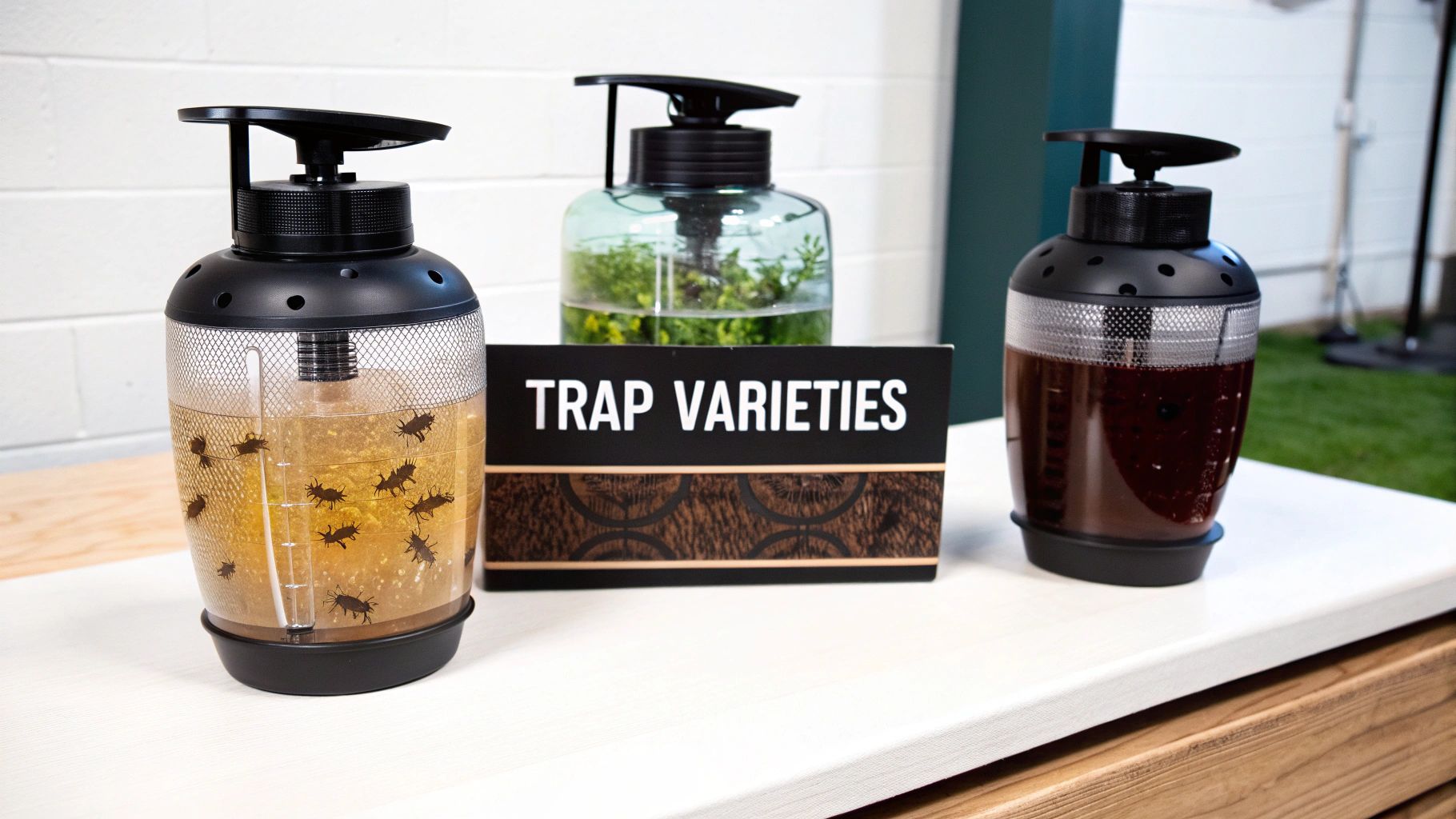
What makes a liquid fly trap so effective? It's not just a random container with sweet liquid. It's a cleverly designed ambush that uses a fly's basic instincts against it. The magic is in two core components working together.
First is the powerful attractant—the bait liquid. This isn't just sugar water; it's a carefully crafted mix of scents flies can't ignore. The best formulas often mimic the smell of fermenting fruit or decaying organic matter, which is exactly what flies are hardwired to find.
Some of the most effective baits even include pheromones, which are chemical signals telling other flies, "Hey, the party's over here!" This potent lure is why a fly will ignore your barbecue to check out the trap. If you're looking for more ways to protect your meals, see our guide on how to keep flies away from food.
The Ingenious Trapping Design
Once the scent lures the fly in, the trap's physical design takes over. The entry points are engineered to be easy to get into but nearly impossible to leave.
Imagine a simple funnel. A fly, following the irresistible smell, easily crawls or flies down the wide opening. But once inside, everything changes. The fly's natural instinct is to fly up toward the light to escape.
The trap’s design cleverly uses a fly's escape instincts against it. The narrow inner opening of the funnel is hard to find from below, preventing them from flying straight out.
This simple yet brilliant structure ensures that once a fly checks in, it can’t check out. It's this combination of an alluring bait and a foolproof physical trap that makes liquid fly traps such a reliable tool for reclaiming your space.
Choosing the Right Liquid Fly Trap
With so many liquid fly traps on the market, how do you pick the right one? It boils down to your specific needs. The best trap for you depends on where the flies are, how bad the problem is, and how much maintenance you're willing to do.
First, consider the location. Are you fighting flies on your patio or in your kitchen? Outdoor liquid fly traps are built for power, using potent baits that flies love but you wouldn't want near your living room. Indoor models use milder, food-based attractants that are much less offensive.
Next, consider the scale of your problem. A small trap works for a few stragglers by the fruit bowl. But for a full-blown infestation near a compost bin or trash cans, you'll need a heavy-duty, high-capacity trap that can hold thousands of flies. For more tips on indoor swarms, you can learn more about which food fly trap is right for you.
Disposable vs. Reusable Traps
One of the biggest choices is whether to get a disposable or reusable trap. Each has pros and cons, depending on whether you prioritize convenience or long-term value.
Disposable traps are incredibly easy. They come ready to go with the bait inside. Just add water, hang it, and when it’s full, you throw the whole thing away. No mess, no fuss—a perfect set-it-and-forget-it solution.
Reusable traps are the more sustainable and budget-friendly choice over time. They cost more upfront and require cleaning, but you can refill them with commercial bait or your own homemade recipes. This cuts down on plastic waste and lets you experiment with what works best.
Liquid Fly Trap Feature Comparison
Here’s a quick side-by-side comparison to make your decision easier.
| Feature | Disposable Traps | Reusable Traps |
|---|---|---|
| Upfront Cost | Low | Higher |
| Long-Term Cost | Higher (must keep buying) | Lower (only need bait refills) |
| Convenience | Maximum convenience | Requires cleaning and refilling |
| Maintenance | None, just toss it | Must empty and wash between uses |
| Sustainability | Generates plastic waste | Eco-friendly, reduces waste |
| Bait Control | Pre-filled, no customization | Fully customizable with DIY or commercial bait |
Ultimately, the choice comes down to your personal preference. If you want a simple, hands-off approach, go with disposable. If you don't mind a little cleanup and want a more economical and eco-conscious option, a reusable trap is the clear winner.
Pro Tip: Be honest with yourself. If the thought of emptying a container of dead flies makes you queasy, the convenience of a disposable model is worth the extra cost.
Reusable traps are also great for DIY solutions, which are often effective and cheap to make.
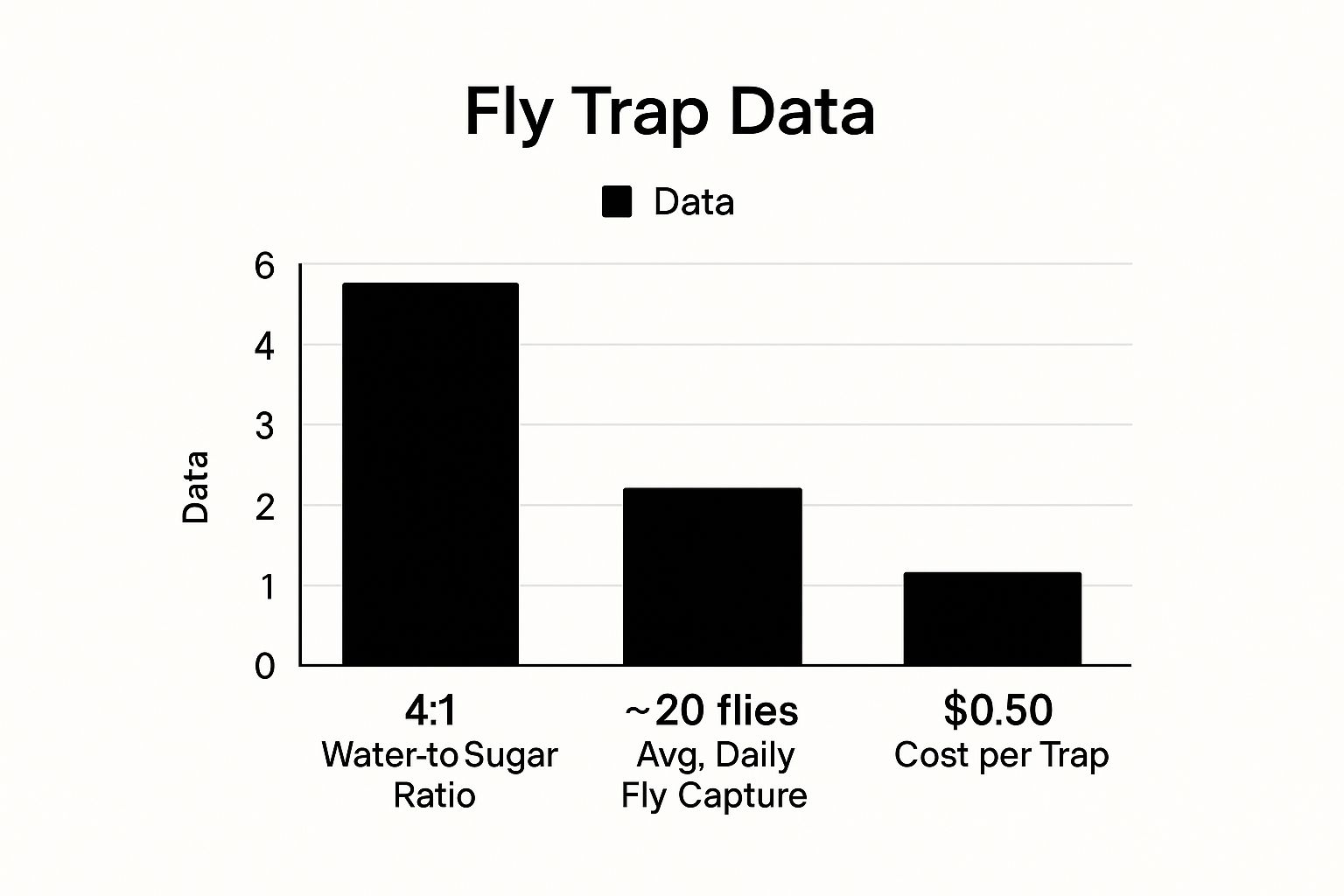
As you can see, a simple homemade bait is both powerful and practically free. This flexibility is what makes reusable traps so appealing—you can balance convenience, cost, and environmental impact to find the perfect fit.
The Big Picture: Why We're Choosing Eco-Friendly Pest Control
The rise of the liquid fly trap is part of a bigger shift away from harsh chemical sprays and foggers. People are actively seeking safer, more sustainable ways to deal with pests. It's more than a trend; it's a fundamental change in how we manage pest control.
At its core, this movement is about protecting what's important. We're more aware of the risks that chemical pesticides pose to kids, pets, and our food. A non-toxic liquid fly trap offers a powerful way to get rid of flies without bringing those chemicals into our homes.
By choosing non-toxic methods, we also reduce our environmental impact. These solutions keep harmful chemicals out of our soil and water, helping build a healthier ecosystem for everyone.
The Market is Listening
This growing demand for greener solutions is making waves. The global fly trap market, valued at USD 294.1 million in 2025, is projected to hit USD 517 million by 2035.
What’s driving this growth? A stronger focus on hygiene and a clear preference for simple, chemical-free products. You can dive deeper into the numbers by reading the full analysis on the growing fly trap market on futuremarketinsights.com.
This trend makes one thing clear: the liquid fly trap is more than just a handy gadget. It’s a smarter, more responsible choice for a modern, health-conscious world. It solves an annoying problem without creating a bigger one, aligning effective pest control with our well-being and the planet's.
Placing Your Trap for Maximum Impact
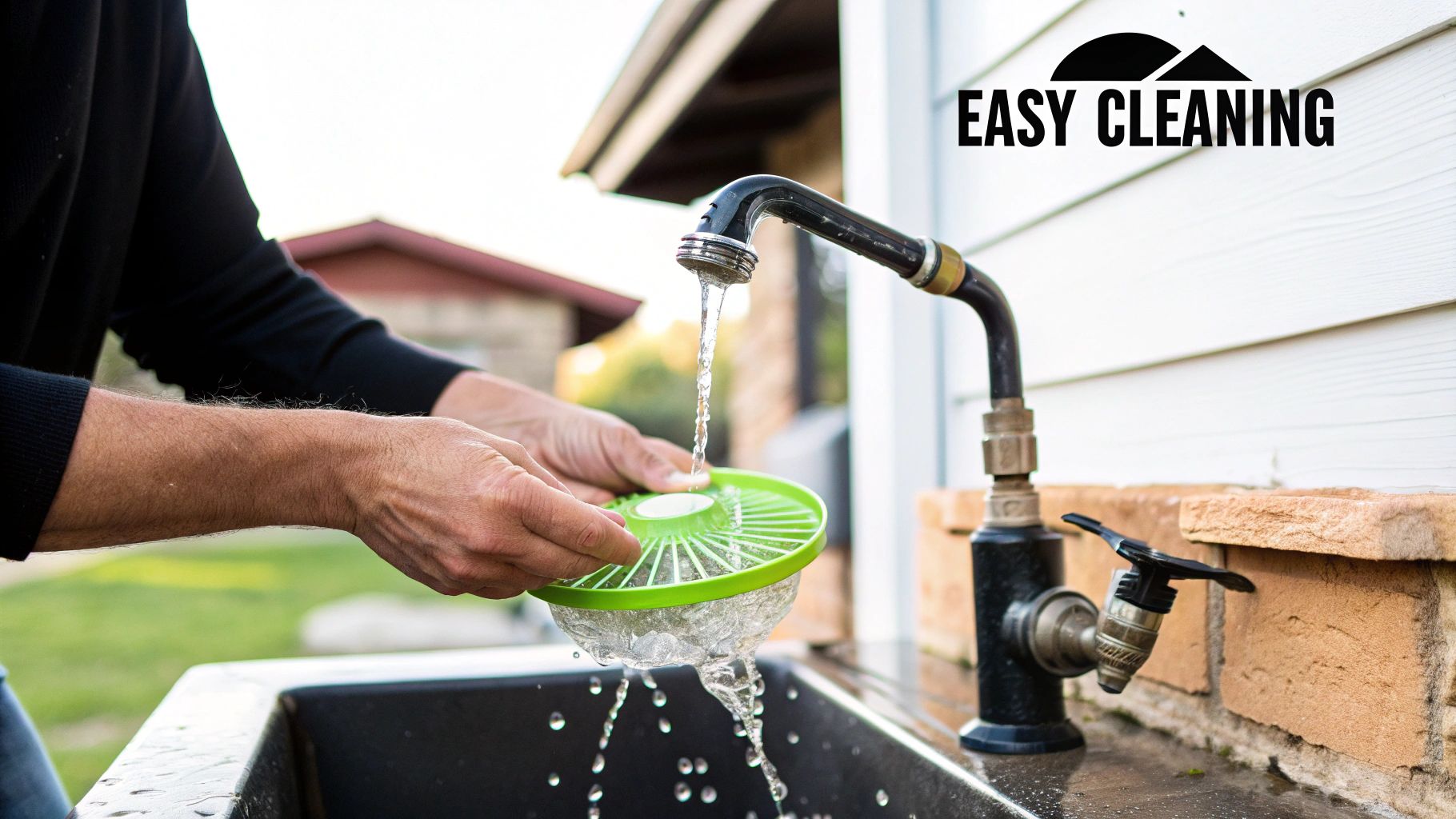
Even the best liquid fly trap is useless in the wrong spot. Placement is the secret to turning a simple container into a fly-catching machine. The key rule is simple, but often ignored: lure flies away from where you are, not towards you.
The most common mistake is hanging a trap right in the middle of a patio or picnic area. This invites flies into your space before trapping them. Think of it as setting up a defensive perimeter. Your goal is to intercept flies before they reach your living area.
For best results, hang your liquid fly trap 10-30 feet away from your main outdoor living spaces. This is the sweet spot—far enough to pull flies away from your gathering but close enough to protect it.
Identify Fly Hotspots
To find the perfect location, think like a fly. What do they want? Where do they hang out? Flies are drawn to food, warmth, and breeding spots, so place your trap in their flight path.
Look for these high-traffic fly zones:
- Near Garbage Cans: The smell from trash bins is a powerful magnet for every fly in the neighborhood.
- Compost Piles: To a fly, a pile of decaying organic matter is a five-star buffet.
- Pet Areas: Dog runs, chicken coops, and other animal enclosures are hotspots.
- Gardens or Dense Shrubbery: Flies rest and sunbathe on leaves and foliage.
By placing your trap near these natural attractants, you’re not fighting against the flies’ instincts—you’re using them. The trap becomes the most irresistible option in an already desirable area, which massively boosts its capture rate.
Don't forget sunlight and wind. A warm, sunny spot helps heat the bait, making the scent more potent and allowing it to travel farther. Always try to place the trap downwind from where you'll be sitting. That way, the odor blows away from you and your guests.
The Future of Pest Control Technology
Even the humble liquid fly trap is getting a high-tech upgrade. The future of pest management isn't about manually checking traps; it's moving toward smart, automated systems that provide real-time information. Technology is changing how we handle even the most basic pest control.
Imagine a trap that does more than just catch flies. New innovations are embedding sensors and cloud connectivity into these devices, turning them into intelligent data points. A smart trap could ping your phone the moment it's full, taking the guesswork out of maintenance.
This shift toward smarter tools is completely changing how we manage pests, especially on a larger scale.
The integration of digital technologies is a key market driver. Smart traps can automatically detect and capture pests, providing real-time data that boosts effectiveness and allows for more efficient resource management.
Data-Driven Pest Management
This forward-thinking approach shows how much a simple tool can evolve. Instead of just reacting to a fly problem, you can proactively monitor their activity levels. Data from smart traps can help pinpoint peak fly hours or identify hotspots, letting you be more strategic.
Technology like the Internet of Things (IoT) is making these sophisticated liquid fly traps a reality. They’re paving the way for systems that don’t just capture pests, but also give you valuable insights to prevent future issues. Learn more about how tech is shaping the industry with these pest control market insights on maiaresearch.com.
Ultimately, this isn't just about convenience. It’s about creating a smarter, more responsive way to keep our spaces clean and pest-free.
Answering Your Top Questions About Liquid Fly Traps
Even with the basics covered, a few practical questions always come up. Let's get them answered so you can use your liquid fly trap with confidence.
What About the Smell?
Let's be direct: outdoor liquid fly traps can get pungent. But that strong smell is a sign it's working. The scent of captured flies adds to the bait's power, attracting even more pests. This is exactly why smart placement is so important.
Are They Safe Around Kids and Pets?
This is a big concern for any family. The good news is that most commercial liquid fly trap baits are non-toxic. Still, it’s always smart to hang them high and out of reach of curious hands and paws to prevent any accidental spills.
Do They Catch Every Type of Fly?
A quality liquid trap is great for common house flies and blow flies. But what about other species?
Fruit flies, for example, are a different game. They're more interested in vinegar or fermenting fruit. If those tiny pests are your main problem, you’ll need a targeted solution. Our guide on how to control fruit flies has specific tips just for them.
The growing demand for effective fly control is a global trend, as urban areas expand and people become more focused on hygiene. This makes choosing the right trap for the right fly more important than ever.
The need for these solutions is booming. In the Asia-Pacific region alone, it's estimated that people will use over 9.5 million fly trap units annually by 2031. You can see more details about the growing fly trap market on kbvresearch.com.
By answering these common questions, you can be sure you're making a smart choice for a pest-free space.
For a modern, stylish, and chemical-free way to protect your indoor and outdoor dining spaces, explore the innovative fly fans from MODERN LYFE. Find your perfect solution at https://modernlyfe.com.

